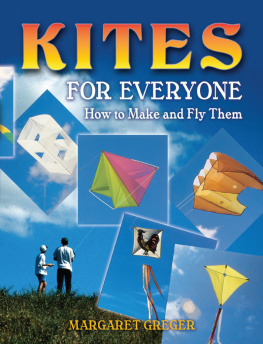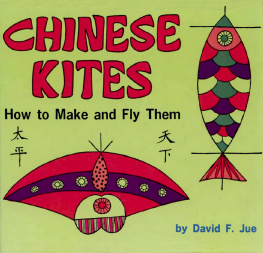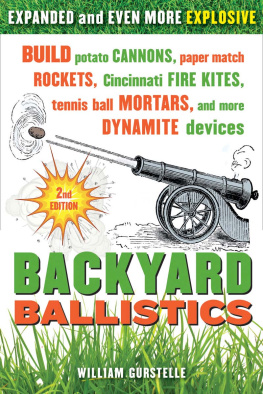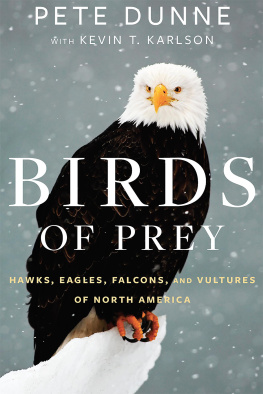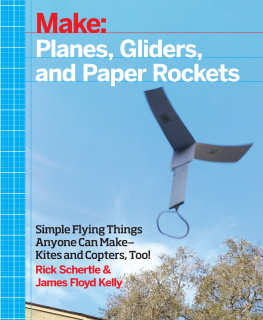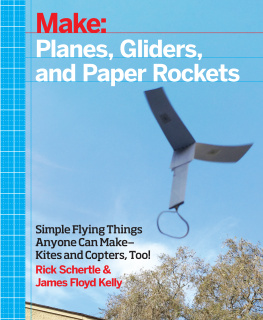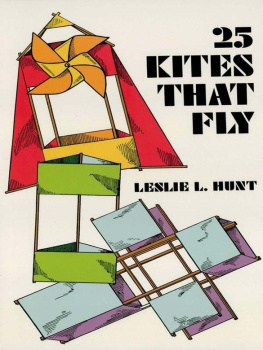Acknowledgements
In a book such as this it is always difficult to give due credit. I am indebted to many generous kitemakers. The dedication in my first book, Blown Sky-High, was to kitemakers, past and present, who have shared their work so generously all the way back to unknown Oriental kitemakers. All of us who make kites are aware of the many hands that preceded ours. Throughout the book I mention various kite designers in connection with the kites which they developed. The list includes Guy Aydlett, A. van Breda, Leonard Conover, Tony Cyphert, Ed Grauel, Gary Hinze, Bill Lee, Joseph Lee, John Loy, Carol Master, Joan Newcomb, Stephen Robinson, Francis Rogallo, Scott Spencer, John Spendlove, Steve Sutton, and Lee Toy.
My own work would not have been possible without the pupils and the teachers in the various schools where, over a period of twenty years, I learned to be the Kite Lady. These include the children and teachers of the Richland, Washington, School District and of Educational Service District 123; the children, board, and staff of Chief Joseph Summer Seminars, Wallowa County, Oregon; and Jack and Frances Ehrig of Locust Grove Press, who printed my earlier books.
Angela Dittmar, Bob Ingraham, Tom Sisson, Bill Tyrrell, Jack Van Gilder, and Vi and Elmo Weeks are also among those who helped. Vi Weeks and Debora Greger read the manuscript. Vi made several of the fabric kites, vetting the patterns. Many hands have worked on the drawings including Joan Newcomb, Pierr Morgan, and Hel. Debora, and Greg Greger.
Debora oversaw this third edition, and it would not have happened without her. Kelly Barber of Gainesville, Florida, brought her formatting and typesetting skills to the task of putting it all together.
V ietnamese Kite
In 1976, in a Bicentennial crafts program in our local schools, I was teaching sixth grade students to make the Siamese Snake Kite, when a boy recently arrived from Vietnam came up holding a piece of the bamboo reed and saying, Can I show you the kite we make in Vietnam? It provides a simple introduction to the kites of the Orient and is one of my favorite classroom kites. Made with the newspaper which covered the work table, this little kite has proved to be a jewel.
Dimensions are given in the layout, as they must be if someone who has not seen the kite is to build it, but when I teach the Vietnamese Kite in the classroom we eyeball it. Some kites will be fat, a few will be skinny, and one or two may be bridled upside-down, but all will fly. There can hardly be a better introduction to kitemaking. There is a pleasing symmetry in having a kite which has delighted Asian children for thousands of years brought to our schools by a new immigrant in our Bicentennial year.
Newspaper and tissue paper are both light enough for a small kite. Crepe paper tails add stability and movement. They may be placed according to the character of the kite (fish or fowl.) Begin with four strips of crepe paper, approximately l" 5'. The dimensions of the bamboo spars vary, because individual kitemakers use different proportions for the folds. They are approximately 14 1/2" for the spine and 22" for the arched cross spar. I break the reeds to the desired length.
Vietnamese Kite Instructions
| Materials: | 12" square of tissue or newspaper, plus scraps
1" wide crepe paper streamers for tails
matchstick bamboo reed
26" string for bridle
gluestick |
Tools: scissors, pencil, ruler
1. Wrong side of paper up, crease on dotted lines.
2. Measure spine and glue in place as shown.
3. Measure the reed for the cross spar. Choose a strong reed with a symmetrical curve. It should arch close to the leading edges.
4. Glue the comer flaps over the reed. Glue one side first, without trying to hold the curve in place; then glue the other side. (Extra hands can help here and kitemakers may want to work in pairs for this step.) Glue reinforcements over the reed intersection and between the center and the comers as shown.
5. TURN KITE OVER and bridle. Glue on tails.
easy to make
easy to fly
light/medium winds

V ietnamese Bag Kite
The Vietnamese Kite can also be made from a high-density polyethylene bag, with the lower part of the bag fringed. The bag should be slightly taller than it is wide. One bag will make two kites. Smaller sizes will work but 16" is large enough to fly well and small enough to be framed with bamboo reed. Trim the sealed bottom edge off. Spread the bag out and flatten the gussets, if any, and slit up the sides.
Fold the bag as shown. Mark the lower edge. Unfold and trim away at the top. Cut the fringe. Now, consult the instructions for the Vietnamese paper kite. The spars are taped instead of glued in place. Bridle as for the paper Vietnamese.
easy to make
easy to fly
light/medium winds

R ogallo Corner Kite
The Comer Kite, patented by Francis Rogallo as a radar reflector, is used here with Rogallo's permission. It is a box kite, a stable flier which loves the wind. After Lawrence Hargraves invented the box kite and gave it to the world in 1893, other inventors began playing with the possibilities of the flying enclosed space, and almost every imaginable solid configuration-cubes, rectangles, prisms, pyramids and cylinders-was tried, many of them by Hargraves. The Comer Kite turns the box inside out, forming a cube with interior comers. With its intersecting vanes, it is particularly easy to make in fabric and the plain/plane surfaces call for the imaginative use of color.
Single-Cell Corner Kite Instructions
| Materials: | two 33" squares of sailcloth
one 5/16" dowel, 4' long
four 1/4" dowels
five 1/2" dia. split rings
20" of 1/2" or 5/8" poly ribbon
16" plastic tubing, inside dia. 1/4"
material for reinforcements |
1. The squares may be hemmed or bound. Since the edges are all on-grain, I usually hem. Draw around the square pattern on the fabric and add 1/2" hem allowance. Lay a straight edge from one comer to another and draw the diagonal on each square. To hem, stitch on the fold lines, then turn the edge twice and stitch the hems.
Reinforce at both ends of the diagonals as shown for the Winged Square Box. Line up the squares, matching and pinning the center lines. Stitch 3/8" on each side of the center and across the ends, forming a sleeve. Leave a 1" opening near the lower edge for spar insertion. (See the Facet Kite for an alternative method for the center spar.)
2. Double the ribbon lengthwise and stitch to make tape for the connectors. Cut it in 4" lengths and stitch to each outside comer as shown. Insert rings. Cut the tubing in 4" lengths, and thread four of the rings through the centers of the tubing. Cut the center spar to size and insert.
Tubing connectors: I use an icepick to make the holes in the tubing and needlenosed pliers to spread the ring and work it through the holes. The holes can also be drilled.
The tubing connectors make spreader adjustment easier. Theoretically, a spreader for a kite made of 33" equilateral triangles should be 33", but this does vary. Start with sticks at least one inch longer and trim as needed. (If too much is cut off, a whole set of spars will have to be put aside for a smaller kite.)
If the spreaders are made just slightly longer than the distance to be spanned they will bow and put tension on the vanes. Taper the spreader tips slightly for easier insertion. Good tension is essential.
Next page
